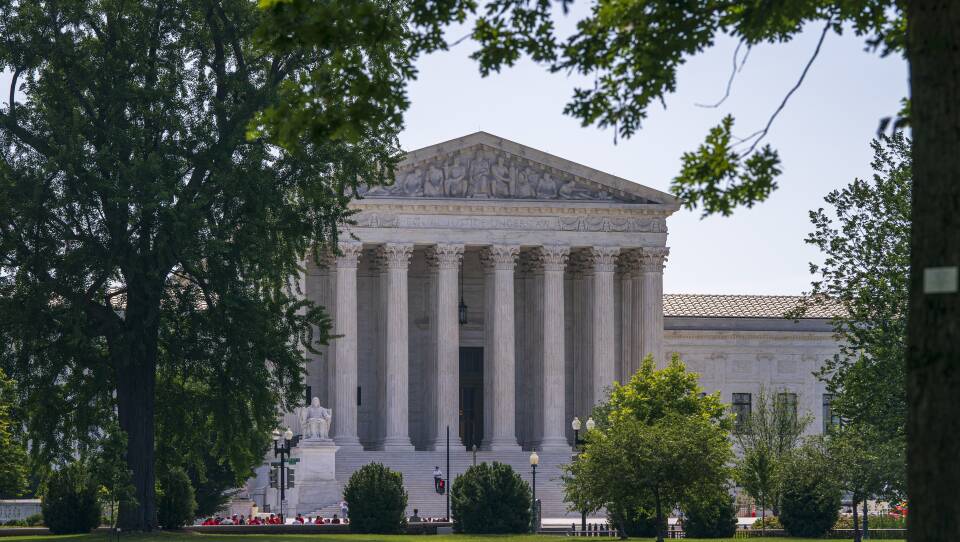The possible overturning of Roe v. Wade has underscored the increasing politicization of the Supreme Court, as five Republican-nominated justices appear on the cusp of retracting constitutional protection for abortion. The situation has prompted calls to reform to the very structure of the nation's highest court. Daniel Medwed, GBH News legal analyst and Northeastern University law professor, joined hosts Paris Alston and Jeremy Siegel on GBH’s Morning Edition to talk about the likelihood and options for reform.
Paris Alston: Many people have criticized how the court is becoming politically polarized and no longer the exception to the decline of bipartisanship we're seeing in the rest of our government. Daniel, do you agree that that's happening? And if so, how big of a problem is that?
Daniel Medwed: Well, absolutely, I agree that it's happening and it's been many years in the making, at least since 2000, with the infamous Bush v. Gore case that halted the Florida recount in the contested presidential election. And I'm no political scientist, as you guys well know, but it seems to match larger political trends out there where the middle is collapsing and the extremes are predominating.
This is deeply worrisome because I think our framers envisioned the judiciary as the branch that was most impervious to the political winds. Of course, the executive branch, the legislative branch, they're worried about being elected. So they're going to be subject to political machinations. The fact that our Supreme Court seems to become so politicized in recent decades is deeply problematic for our entire government structure.
Jeremy Siegel: So there's rising partisanship, there's broad concern about that. You yourself have said it's worrisome. There are proposals for reform out there. Massachusetts Senators Markey and Warren have pushed to expand the number of justices on the court. Is there any constitutional barrier to doing something like that, expanding the court?
Daniel Medwed: Actually, there isn't. There's nothing in the Constitution that fixes the number of justices on the court. And it's up to Congress to change the number as it sees fit, presumably through simple legislation. When you look back in history, the number of justices has fluctuated over time. I think it's changed something like seven times.
Originally, there were six justices, then John Adams reduced it to five essentially to thwart Thomas Jefferson from getting an extra appointment. Jefferson bumped it up to seven. The number changed during the presidencies of Andrew Jackson, Abraham Lincoln, Andrew Johnson, and ultimately went up to nine during the administration of Ulysses Grant, after Grant was upset about a decision that he deemed inconsiderate to his administration. So when you look back on history, the number has ebbed and flowed and political variables seem to be the driving force in changing the number.
Alston: And of course, there was that time that FDR tried to pack the court, but I understand that didn't work out so well.
Medwed: No, that's right. Back in 1937, FDR tried to increase the number of justices to 15. That prompted vigorous opposition from the Republicans. I think the same thing would happen today if Democrats tried to increase the size of the Supreme Court. And as long as the filibuster is in place, it might be really hard to do.
Siegel: So, Daniel, let's say expansion isn't politically viable, which it sounds like you're saying it isn't. What other changes could, in theory, be used to shift the political dynamic on the court?
Medwed: So one idea with or without expansion is to have only a portion of Supreme Court justices hear each case rather than the full nine. This is how it works in the lower federal appeals courts. So, for instance, here in Massachusetts, where we have the First Circuit Court of Appeals, there are lots of judges, but they tend to only hear cases in panels of three. And seldom does the full court — it's called en banc review — hear a case.
So you could do the same thing with the Supreme Court. You could just randomly select three justices to hear a particular case. Now, given the current six-three conservative majority with Roberts a somewhat oscillating sixth conservative, it might not necessarily change many results, but it could lead to a more diverse set of opinions and on the margins could change some outcomes. So that's something to consider as well.
"There's a lot of precedent for the idea of term limits for judges."-Daniel Medwed, legal analyst
Alston: And one other idea that's been floating around is concerns about term limits. I know some House Democrats have even introduced a bill that would give Supreme Court justices staggered eighteen-year terms instead of the lifetime appointment. Could that actually happen?
Medwed: I think it could, and here's why. So on the one hand, that reform seems less dramatic than expanding the number of justices and also more justifiable. So first, it's far-fetched to think that our framers could envision life expectancy as it exists today, that they couldn't imagine that say, John Paul Stevens could spend 34 years on the Supreme Court and retire at the age of 90. So surely the framers would think that these very, very, very long tenures for Supreme Court justices were not what they had in mind.
Second, every state Supreme Court in the nation, with the exception of Rhode Island, either has fixed terms for the highest court state judges or mandatory retirement age. For instance, here in Massachusetts, the SJC justices have to retire at the age of 70. So there's a lot of precedent for the idea of term limits for judges. On the other hand, there may be a constitutional problem here because Article Three of our Constitution says that federal judges may serve during good behavior. Basically, that's what gives them life tenure. So if there's opposition to the idea of legislation to create term limits, it could mean that the only way to do this is through a constitutional amendment. And that is a very, very difficult road.









